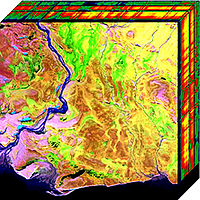
Photo from wikipedia
Near infrared (NIR) hyperspectral imaging and Fourier transform mid infrared (FT-MIR) microspectroscopy were explored in the current study to investigate how constituent elements of sweet potato change during cooking, and… Click to show full abstract
Near infrared (NIR) hyperspectral imaging and Fourier transform mid infrared (FT-MIR) microspectroscopy were explored in the current study to investigate how constituent elements of sweet potato change during cooking, and in the meantime, to identify sweet potato varieties. Partial least square discriminant analysis (PLSDA) model was established to classify varieties of sweet potato, and the correct classification rate of the PLSDA model using Spectral Set I (964–1645 nm) reached as high as 100%. Competitive adaptive reweighted sampling (CARS) was introduced to choose incipient feature wavelengths from three spectral subsets related to tuber cooking loss (CL). Based on 8 feature variables from Spectral Set I, CARS-SVMR model performed best with the highest coefficient of determination in prediction (R2P) of 0.893 and the lowest root mean square error of prediction (RMSEP) of 0.075. Then, these three subsets of feature wavelengths selected by CARS were re-optimised by using successive projections algorithm (SPA). With 7 feature variables from Spectral Set II (3996–600 cm−1) suggested by CARS-SPA, the CARS-SPA-PLSR model predicted tuber CL with R2P of 0.773 and RMSEP of 0.079. Moreover, the CARS-SPA-PLSR model using 5 wavelengths from Spectral Set I exhibited good prediction result, with R2P of 0.913 and RMSEP of 0.058. Although both techniques are capable of determining sweet potato CL in an effective way, the NIR technology demonstrates better predictive capability based on the reduced CARS-SPA-PLSR model.
Journal Title: Biosystems Engineering
Year Published: 2019
Link to full text (if available)
Share on Social Media: Sign Up to like & get
recommendations!